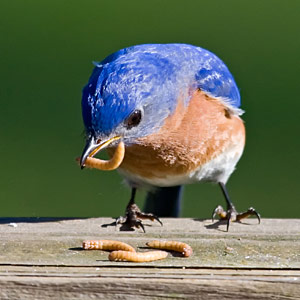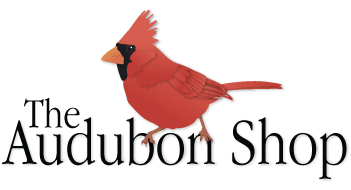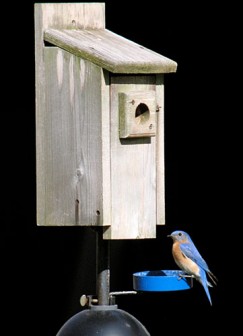Nesting Box 101
Nesting Box 101 will offer you the nuts and bolts of how to place and maintain nesting boxes, also known as bird houses, in your yard.
We often field phone calls and questions about buying nesting boxes and the best placement and maintenance of them, so it’s time to write it all down!
Here’s Part One, because it’s fascinating to know the science behind where birds nest. Part two will be placement of boxes and maintenance.
At The Audubon Shop we follow best scientific and proven practices to try to ensure success for the birds as well as our customers, so all of our nest boxes have been built to specifications shared by biologists.
We also carry boxes that are easy to clean out, because one must clean out old nests for the safety of the birds.
When? As soon as the bird is done nesting. Eastern Bluebirds, for example, can have multiple broods per season (April-June). They will build a nest EVERY time they nest, so pretty soon your box will be full of old nesting material. Your nestlings are in danger of predation, in that case.
Our nesting boxes all have an easy no-tool way to open them for cleaning. Some of them have a side or a front that flips up, some have a secret back covered panel, some open from the top.
Birds that will use a nest box are those that use a tree cavity in the wild. Biologists have studied these birds’ nesting habits, and have noted that each species use cavities with a specific size entry hole and of a specific cavity depth.
In the wild, Black-capped Chickadees, for example, search for small woodpecker holes in dead trees and will excavate the hole to their preferred depth. They gather nesting materials such as fur, feathers and hair to line the cup of their nest for egg laying. Eastern Bluebirds, Tree Swallows, House Wrens, and Titmice (very occasionally) are song birds that will also use a cavity in the wild, and therefore will also use a nesting box that mimics those wild cavities.
Each species builds nests out of its own preferred materials, also: grasses, leaves, fur, feather, mosses. There are field guides dedicated to identifying nests by the materials used.
*It’s also helpful to know that one should not put up multiple boxes in your yard or trees, not only if you want success, but also if you want be a good bird landlord. Science teaches us that birds are territorial, especially during nesting time. A minimum of 25-30 ft. between boxes is best.
Below are birds that use cavities or man-made platforms to nest in CT.
For info on the birds in your region, and also on WHERE to place nesting boxes, check Cornell Lab of Ornithology’s excellent site: Nest Watch
CT songbirds that will use a nesting box in your yard:
- Black-capped Chickadee, Eastern Bluebird, Tree Swallow, House Wren, and (not as common) Pileated Woodpecker, Titmouse, White-breasted Nuthatch and Red-breasted Nuthatch, Red-bellied & Downy Woodpeckers, Flicker, Great Crested Flycatcher
- A 1″ hole will accommodate House Wrens only. Check out our Wren Houses, such as the Cedar Hanging Wren House
- A 1.125″ hole will accommodate House Wren, Chickadee and Nuthatches
- A 1.5″ hole will accommodate House Wren, Chickadee, Bluebird, Tree Swallow, Titmouse, Downy Woodpecker – such as the entry hole on our Bluebird Nesting Box
Songbirds that will use a nesting shelf:
- American Robin, Eastern Phoebe and Carolina Wren, Barn Swallow
Raptors that will use a nesting box or a platform:
- Screech Owl, Barred Owl, Great-horned Owl, Kestrel, Osprey
Ducks that will use a nesting box:
- Wood Duck, Hooded and Common Merganser, Common Goldeneye
As mentioned above, a great, long lasting cedar box that will accommodate a wide variety of songbirds is the Bluebird Nesting Box
Our wren houses are the perfect size for small and loud House Wrens, here’s a sweet one: Recycled Wren House
And, if you’re lucky enough to live in the deep woods (Screech Owl) or near a pond (Wood Duck), come in to take a look at what we offer.
Knowing your neighborhood habitat is key. Also, patience is key!
- The songbirds mentioned above are among the easiest to attract using a man-made box. That’s because most of us live in suburban areas where these birds occur.
- If you are located near water, you may have seen Wood Ducks or Mergansers. They are quite shy or skittish, but you may have success offering them a box.
- If you have deep woods on your property, a box for Screech or Barred Owls may work.
- Osprey platforms are now dotting the CT shore and rivers.
- *A note about Osprey. The CT Dept. of Energy & Environmental Protection is charged with giving permits for Osprey platforms, so you must contact them if you’d like one in your yard near a marsh or river. CT DEEP

Eastern Bluebird male, picking up mealworms to feed his young. Photo courtesy of Jack Faller.

